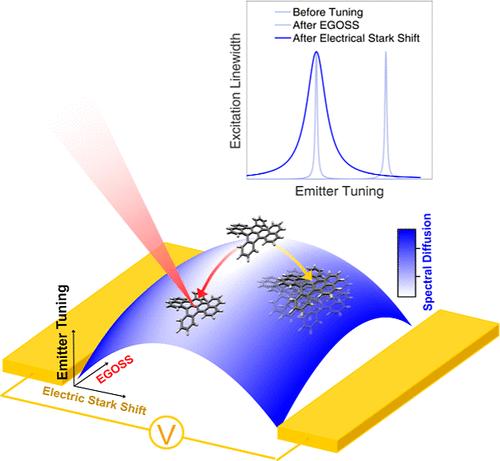增强对单分子发射频率和光谱扩散的控制
IF 15.8
1区 材料科学
Q1 CHEMISTRY, MULTIDISCIPLINARY
引用次数: 0
摘要
斯塔克效应为移动分子、原子和一般电子跃迁的光谱提供了强有力的方法,成为通过静态电场调节量子发射器频率的最简单、最直接的方法之一。与此同时,为了降低发射器对电荷噪声的敏感性,通常会设计反转对称系统,以提供稳定的发射频率,而发射频率与外加电场只有二次关系。然而,这种非线性行为可能反映在调谐能力与不必要的光谱波动之间的相关性上。在此,我们利用冷却至液氦温度的固态分子量子发射器为这一趋势提供了实验证据。最后,我们将电极产生的平行于分子诱导偶极子的电场与垂直于分子诱导偶极子方向的光激发长寿命电荷态结合起来。基于分子极化性的各向异性,我们对局部电场的二维控制不仅可以调整发射器的频率,还能有效抑制与电场波动相关的光谱不稳定性。本文章由计算机程序翻译,如有差异,请以英文原文为准。

Enhanced Control of Single-Molecule Emission Frequency and Spectral Diffusion
The Stark effect provides a powerful method to shift the spectra of molecules, atoms, and electronic transitions in general, becoming one of the simplest and most straightforward ways to tune the frequency of quantum emitters by means of a static electric field. At the same time, in order to reduce the emitter sensitivity to charge noise, inversion symmetric systems are typically designed, providing a stable emission frequency with a quadratic-only dependence on the applied field. However, such nonlinear behavior might be reflected in correlations between the tuning ability and unwanted spectral fluctuations. Here, we provide experimental evidence of this trend using molecular quantum emitters in the solid state cooled down to liquid helium temperatures. We finally combine the electric field generated by electrodes, which is parallel to the molecule’s induced dipole, with optically excite long-lived charge states acting in the perpendicular direction. Based on the anisotropy of the molecule’s polarizability, our two-dimensional control of the local electric field allows us not only to tune the emitter’s frequency but also to sensibly suppress the spectral instabilities associated with field fluctuations.
求助全文
通过发布文献求助,成功后即可免费获取论文全文。
去求助
来源期刊

ACS Nano
工程技术-材料科学:综合
CiteScore
26.00
自引率
4.10%
发文量
1627
审稿时长
1.7 months
期刊介绍:
ACS Nano, published monthly, serves as an international forum for comprehensive articles on nanoscience and nanotechnology research at the intersections of chemistry, biology, materials science, physics, and engineering. The journal fosters communication among scientists in these communities, facilitating collaboration, new research opportunities, and advancements through discoveries. ACS Nano covers synthesis, assembly, characterization, theory, and simulation of nanostructures, nanobiotechnology, nanofabrication, methods and tools for nanoscience and nanotechnology, and self- and directed-assembly. Alongside original research articles, it offers thorough reviews, perspectives on cutting-edge research, and discussions envisioning the future of nanoscience and nanotechnology.
 求助内容:
求助内容: 应助结果提醒方式:
应助结果提醒方式:


